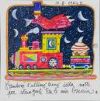|
ESL Forum:
Techniques and methods
in Language Teaching
Games, activities
and teaching ideas
Grammar and
Linguistics
Teaching material
Concerning
worksheets
Concerning
powerpoints
Concerning online
exercises
Make suggestions,
report errors
Ask for help
Message board
|
ESL forum >
Techniques and methods in Language Teaching > Substitute teacher..help
Substitute teacher..help
|

Baadache

|
Substitute teacher..help
|
|
Hello,
I recently
work as a substitute teacher in primary and secondary schools in Quebec. It is not that easy when you replace teachers.
I just want to know if you have ever worked as substitute teachers .....how did you manage your class...what tricky things that
calm down pupils, how could
you make the difference I hate to recieve a note because of being unable
to control my class. Please, I ´ll be so happy if you can share any of your successful strategies and experiences.
I thank you in advance,
|
23 Mar 2013
|
|
|
|

Lancillotta:

|
Hello Baadache,
in Italy it is the same: students usully don �t respect substitute teachers .
I found this article : http://www.guardian.co.uk/society/joepublic/2010/feb/09/pupil-behaviour-management-tips
I hope it helps.
What I usually do is:
- I draw a map of the class so that I can call pupils using their names. To do that, with all the time I need (5-10 minutes), I give them a wordsearch or a WS like this http://www.highlightsteachers.com/teachers-toolbox/hidden-pictures
They love this kind of things, so they are quiet for the time they need to colour or circle the words.
I ask, student by student, fist name and name and I check if it is right in the classroom register.
When I call them with their names They feel much more involved and responsible.
Have I nice day and GOOD LUCK!
Sabrina |
24 Mar 2013
|
|
|

cunliffe

|
Great links, Lancillotta. |
24 Mar 2013
|
|
|

abumohamed

|
|
Hi, I hope that the following article about settler teaching activities might help you. And always remember this rule : Occupy your pupils before they occupy you.
Stirrers and settlers for the primary classroom Submitted by TE Editor on 25 February, 2010 - 10:57 Teaching in the primary classroom is very different from teaching teens or adults because of the amount of energy children have! Knowing how to channel this energy, or when to �stir � and when to �settle � children will help you achieve balanced lessons without children becoming over-excited on the one hand or bored on the other. Teachers need to take many factors into consideration when planning a balanced primary lesson and it is important to plan varied lessons. - Different kinds of activities to practise the different skills need to be balanced against each other.
- Teachers need to be aware that children have a much shorter concentration span than adults and this will affect the number of different activities we plan for a single lesson.
- Pace and timing are important considerations - at primary level it is better to use short, sharp activities so that children can sustain their attention. If concentration flags, change the activity. Teachers need to plan a balance of �heads up � and �heads down � activities, alternating the interaction patterns between individuals/pairs/groups and whole-class activities.
- Likewise teachers will need to take into account the learning styles of the different children in the class. Different types of activities will be more suited to visual/ auditory/ kinaesthetic /tactile learners.
- Finally, there is often a need to build in some �quiet time � into a lesson. This time helps students as well as teacher sanity. Silent reading or an individual quiet activity can help prepare a class for learning - for example if they arrive after a noisy P.E. lesson. The teacher can take the opportunity during these kinds of activities to deal with classroom admin, check who knows what and/or give individual help where necessary.
Analyse a lesson!
Think about any lesson you have taught recently and analyse the pattern and balance of the lesson. Draw a graph with a horizontal and vertical axis. Write the activities you did with the class on the bottom axis and then plot the noise and activity level. Remember noise is not always negative! Then analyse your graph. Are there any parts of the lesson which needed more �stirring � or more �settling �? This technique is useful to evaluate a lesson you were not happy with and can help you to pinpoint the areas to plan in greater detail. Settling students
�Settlers � are activities which are designed to calm students down and settle them into a routine. Basic classroom management and routines are essential to establish as a pre-requisite for learning. Make sure children know what the routine is when they arrive in class e.g. coats off, books out, files or folders on the desk/under the chair. This is especially important in larger classes or tight working spaces so that valuable teaching time is not lost. Have a clear signal to get the children �s attention and make sure children know what it is. Clap your hands, bang the board rubber, say a signal word clearly and hold up your hand - try not to just shout at your students. Settler activities
Use simple vocabulary categorising or brainstorming activities. For example give children 12 words randomly across the board and ask them to put them into the correct category. Revise familiar lexical sets - clothes, colours, numbers, animals or reinforce the topic you are currently teaching. Ask children to add other lexical items. | Mammals | Reptiles | Birds | Insects | | | | | |
- Prepare for listening or speaking exercises by asking children to copy simple prompts from the board. For example, give children a list of five food items to copy and ask them to add five more. Then use the list for simple pair work or listen and tick practice.
- Wordplay activities
Use matching activities with pictures and words or phrases, anagrams, missing letters, definitions games, jumbled sentences, wordsearches, crosswords. Children love puzzles so get them using their brains! - Whole-class listening activities or games
Try doing a simple picture dictation asking children to draw a fun or crazy picture. With very young learners you could dictate a monster or alien to practise colours/parts of the body. With more advanced learners you could build up a crazy scene, practising all the prepositions. - Read and draw activities
Give children a short reading text e.g. description and ask them to draw what they read about. For a good example see the worksheet �My Ideal Room � on the Learn English Kids website. Go to http://www.britishcouncil.org/kids-print-ideal-room.pdf - Use stories or storybooks
Practise your story-telling technique! Alter your classroom if you can for �storytime �. Small classes of Very Young Learners can sit on the floor in a semi-circle round the teacher to enable you to exploit pictures and explain meaning.
With larger classes make photocopies and enlarge pictures of characters and places to stick up on the board as you tell or read the story. - Arts and crafts activities
This type of activity requires thorough preparation! Introducing creative and design elements caters for a wide range of learner. Give clear instructions so that children can settle into the task once they start. Try making class wall displays, mini-projects, a class book or other cut and stick activities.
Stirring students
Let your students move around as much as possible. In large classes with a lot of furniture this will require some planning. Vary pairs and groups by assigning random numbers. With large classes organise �Home � groups so that children move into these automatically for group work. Encourage movement as much as possible. Even asking children to come out to the front and write an answer on the board provides variety and livens up dull exercises. Stirring activities - Mingles or surveys
Use games which encourage children to act with lots of others if you have the space. Activities such as � Find someone who..? � are a good way of drilling without being boring. Try this game: Animal stickers. Prepare a sticker with an animal name for each child and stick it on their backs. Children walk around asking questions to find out what they are. - Use action/movement games
Word circle games e.g. throwing the ball to revise interchanges or vocabulary sets are a useful way of getting all children moving and participating. Clapping and clicking games are good for larger classes as they involve movement without too much hassle. Any team games running to the board are extremely motivating because of the competitive element. Mime games are also a good way of getting children moving. - Use TPR as a regular part of classroom routines and activities. For example in listening activities : Put your hand up when you hear ...!
- Use songs, chants and raps
All children are motivated by songs and these kinds of activities are all-inclusive, catering for all levels of learner. Sing songs or say chants faster and faster to really stir them up! A really good example of this can be found in the Learn English kids website with the traditional song �If you �re happy and you know it �. Or divide your class into groups and allocate parts to sing or sing in a round. - Use drama/acting out
Puppets or masks can really bring alive a dialogue, role-play or story. Make simple masks out of paper plates for main characters. Bring in realia and props for children to use for acting out e.g. some real money and a bag for shopping. Have a dressing up box of simple props such as hats, glasses etc. Puppets or finger puppets can be used to liven up even the most boring dialogue, especially when accompanied by funny voices! - Make the most of technology
If you are fortunate enough to have a computer in the classroom exploit the free resources available on the internet fully. The LearnEnglish Kids website provides a huge range of games, songs and stories to liven up and �stir � children. Another very useful site providing materials on a huge range of topics is �Enchanted Learning �. Go tohttp://www.enchantedlearning.com/
Written by Sue Clarke, Teacher and teacher-trainer, British Council, Coimbra, Portugal First published in 2008
|
24 Mar 2013
|
|
|
|
|

iodent

|
|
Hope your studets get better :)
It �s also a big problem in Korea, too. |
24 Mar 2013
|
|
|

rafo

|
|
very familiar to me....why don �t you try using some sogs,they usually work , and also you can try hoing for a walk to give them a task later such as a description what had they seen ?? ask about their favourites.....extra worksheets, they will love you....and then look up to you |
24 Mar 2013
|
|
|